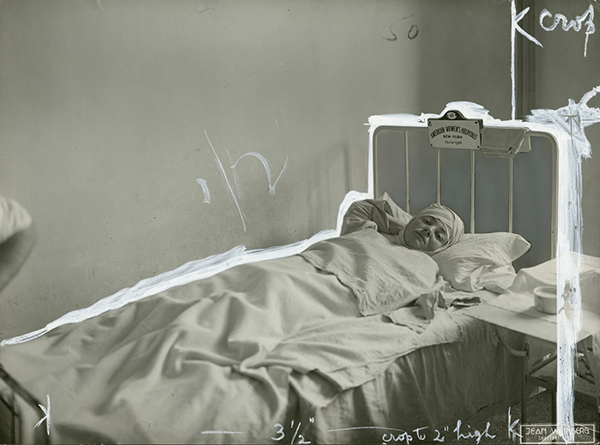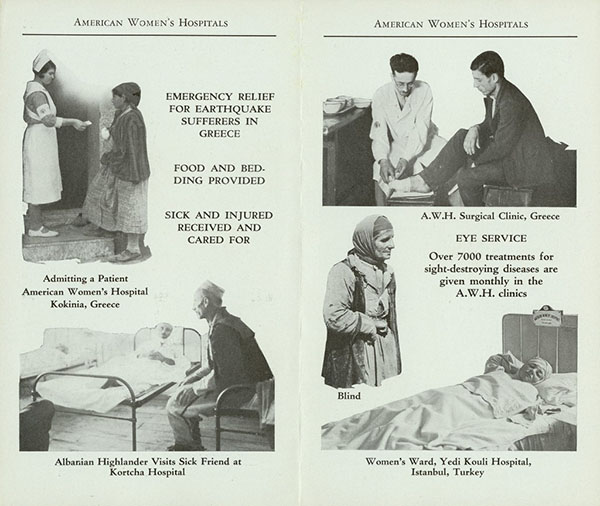Picture Perfect: Teaching Analysis Skills with Fundraising Photography
by Elliott Earle, Educator Content Developer for Doctor or Doctress

A patient in the American Women's Hospitals' Women's Ward in Istanbul,
Turkey.
Primary source analysis is a mine of educational value for social studies
teachers. Working directly with materials from the past allows students to
confront the complexities of history head-on and take ownership of their
learning. But in this teaching treasure trove, one of the most valuable gems
is often overlooked: photography. In many classrooms, primary source analysis
tends to revolve around text-heavy documents. But with the right tools,
pictures can engage many of the students that text sources could potentially
push away, while working the same critical thinking muscles.
It’s tempting to let those muscles take a break when looking at an old
photograph. The information found in frame seems more reliable and true than a
written account of that same scene.1 But just
like any other primary source, an image always has an "author" and is rarely
ever completely objective. "Sourcing heuristics"—that toolbox of questions
historians and students use to interrogate a source's context, author, and
purpose—are as important as ever when using historical photographs with
students.
Established during WWI to provide medical care to the devastated parts of
Europe, the American Women's Hospitals was one organization that left behind a
great deal of photographic documentation of both their foreign and domestic
work. Of the three collections on
Doctor or Doctress
that focus on the work of the AWH, two of them lean heavily on images to tell
the story. Like any other non-textual source brought into the classroom, these
stories will give some variety to any primary source analysis muscle workout
routine. But what the American Women's Hospitals in particular can offer is a
great opportunity to discuss the reliability of images and the importance of
the person behind the camera to what is captured in it.

The bandaged patient from above has been masked and cropped to fit on this
fundraising brochure page.
The pictures taken by the AWH depicting the
refugee crisis in Greece and Turkey following the fire of Smyrna
or the
conditions of the rural poor in Depression-era Appalachia
are important accounts of those situations, but like any written account,
they must be analyzed with a critical eye. Why was this image taken? What
were the photographer's goals? For the American Women's Hospitals, the
answer was frequently, if not almost always, fundraising. Photography was
critical to the AWH fundraising efforts stateside. Dr. Esther P. Lovejoy,
president of the AWH, complained in a letter to one of the organization’s
doctors that "THIS NATION HAS BECOME ILLITERATE IN THE ORDINARY SENSE. THEY
WILL NOT READ: THEY MUST SEE THINGS IN PICTURE FORM."2
Doctors in the field were often directed to capture scenes (either candid or
posed) on camera that would likely prove fruitful in their next brochure.
Dr. Lovejoy sent frequent letters scolding Dr. Etta Gray for not sending
back useful photos of AWH work where Dr. Gray was stationed in Serbia. "It
is just as hard for me to raise money on this side... without pictures of
the sick," Dr. Lovejoy wrote, "as it would be for you to run your hospital
without money."3
The AWH needed pictures and stories that would tug at the heartstrings of
America. In an exasperated complaint to Dr. Gray at the lack of useful
material being sent to headquarters, Dr. Lovejoy explicitly stated the kinds
of pictures they should be taking:
All I am able to get is some picture of a woman in uniform doing nothing in
which nobody is interested, and what I want is pictures of long lines of
wretched looking people and children standing in their dispensaries. We want
pictures of people sick in bed. We want pictures of people who have been
restored to health with a complete story under the picture regarding these
people... We want pictures of people who were blind, at the time when they
were blind and then pictures of those same people after their sight has been
restored by the work done by the medical women of the American Women's
Hospitals.4
These were the principles that guided members of the AWH in their efforts to
document the organization's work. And the influence of the creator's
motivations to what is shown in an image often extends beyond the actual act
of taking the picture. Many students today have a keen eye for spotting traces
of photo editing software in the pictures they see in their daily lives, but
it might surprise them to learn that this practice was also in use in the
early 20th century. Whether it was to accentuate certain aspects of the scene
or to help fit all of the pictures on a brochure page, the AWH photographs
were subjected to editing once they were developed. The evidence of this
editing is still visible: signage and AWH logos drawn over in pen for
emphasis, cut-outs, and crop marks can be seen throughout the original copies
in the records.
Is photo editing an inherently dishonest practice? How did the pressure from
headquarters impact the scenes that were captured in the field? What might
have been left out? Does the ultimate mission of the AWH impact how we judge
them for these practices? These are just a few of the complicated questions to
be wrestled with in light of this evidence. It forces the viewer to recognize
the layers of intent and bias between themselves and the scene captured in
that image, a vital skill to have for a classroom of budding historians.
1 Susan Sontag encapsulated the idea in her
essay "On Photography" when she wrote that unlike written documents, "[p]hotographed images do not
seem to be statements about the world so much as pieces of it, miniatures of
reality that anyone can make or acquire."
2 Dr. Esther P. Lovejoy to Dr. Etta Gray, 19
February 1921, Records of the American Women’s Hospitals, Box 15, Folder 129.
3 Lovejoy to Gray, 16 March 1921, Records of
the AWH, Box 15, Folder 129.
4 Lovejoy to Gray, 11 January 1921, Records of
the AWH, Box 15, Folder 129.